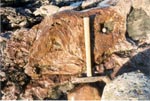Rocks could reveal secrets of life on Earth - and Mars
Published: 9 October 2003
New UK project helps detect evidence of life on Mars
A new UK project could help detect evidence of life on Mars and improve our understanding of how life evolved on Earth. The aim is to develop a technique that can identify biomolecules in water that have been trapped in rocks for millions to billions of years.
The three-year initiative will be carried out by geologists and bioengineers at the University of Aberdeen and the University of Glasgow, with funding from the UK's Engineering and Physical Sciences Research Council.
The initiative is being led by Dr John Parnell of the University of Aberdeen's Geology and Petroleum Geology Department, in collaboration with Professor Jonathan Cooper of the University of Glasgow's Department of Electronics.
Professor Cooper says, 'With our collaborators in Aberdeen, we are fortunate to have the possibility of working on one of the most exciting projects in the universe, the search for life on other planets!'
As well as analysing samples from Earth, the technique could be used to obtain important information from water sealed within rock samples brought back from Mars. The team will also consider how the technique could be miniaturised for incorporation into spacecraft that travel to other planets.
The research will explore significant technological challenges at the interface between the physical sciences and engineering. These include microfluidic methods for sample pre-concentration (ie the extraction and handling of exceptionally small amounts of fluid), single molecule detection technologies to locate very small amounts of biomaterials and the elimination of contaminants.
The project is highly innovative, attempting to access a source of biomolecules that have not been tapped before. Analysis of material dating from the time before the Earth's fossil record became extensive is a major project aim, potentially resulting in our knowledge of the development of life on Earth being significantly enhanced.
Media Relations Office (media@gla.ac.uk)
The research initiative, 'Detection of Biomolecules from Evolving Life on Earth and Mars', will receive Engineering and Physical Sciences Research Council funding of nearly ?428,000.
In the proposed technique, rock samples will first be crushed to release tiny volumes of trapped water. Bio-nanotechnology and specifically SERRS (surface enhanced resonance Raman scattering) will then be used to detect the presence of tiny levels of biomolecules in the water. This will provide evidence for the existence and nature of any life that was in the samples when the water became sealed in the rock.
SERRS is a technique in which biomolecules can be identified by their interaction with electromagnetic fields at a modified metallic surface (usually silver or gold).
Biomolecules are organic compounds that originated in a biological (i.e. living) precursor.
The project team will start by proving the technique using material like DNA, but will go on to use molecules that represent the remains of bacterial cells.
The Engineering and Physical Sciences Research Council (EPSRC) is the UK?s main agency for funding research in engineering and the physical sciences. EPSRC invests more than ?400 million a year in research and postgraduate training to help the nation handle the next generation of technological change. The areas covered range from information technology to structural engineering and from mathematics to materials science. This research forms the basis for future economic development in the UK and improvements in everyone?s health, lifestyle and culture. EPSRC also actively promotes public awareness of science and engineering. EPSRC works alongside other Research Councils with responsibility for other areas of research. The Research Councils work collectively on issues of common concern via Research Councils UK. For further information on EPSRC visit the webiste: EPSRC
For further information, contact:
Angela Ferguson, Communications Team, Office of External Affairs, University of Aberdeen, Tel: 01224 272960, e-mail: a.ferguson@abdn.ac.uk. Dr John Parnell, Geology and Petroleum Geology Department, University of Aberdeen, tel: 01224 273 464, e-mail j.parnell@abdn.ac.uk
Judith Hodgson Press Officer, University of Glasgow, tel 0141 330 3535, e-mail j.hodgson@admin.gla.ac.uk. Prof. Jonathan Cooper, Department of Electronics, University of Glasgow, Tel: 0141 330 4931, e-mail: jmcooper@elec.gla.ac.uk
Two Images (Rock history 1 jpg and rock history 2 jpg) are available from Jane Reck, EPSRC Press Officer, Tel: 01793 444312, E-mail: jane.reck@epsrc.ac.uk with the suggested caption 'Rock history - rocks like these could shed new light on how life evolved'.
First published: 9 October 2003
<< October


